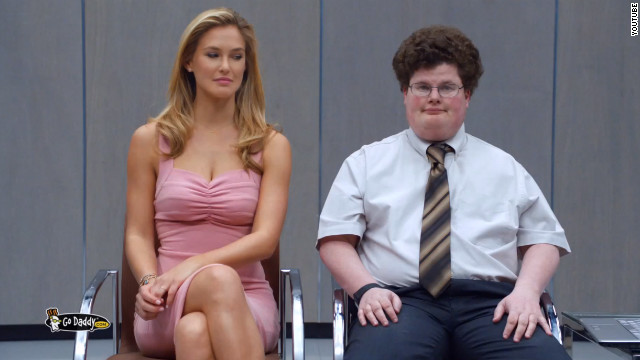
 GoDaddy advertising is getting a facelift.
GoDaddy advertising is getting a facelift.
The web hosting platform and domain provider has long been known for its raunchy advertising. After all, who could forget the icky, seemingly never-ending liplock between supermodel Bar Rafaeli and a pudgy, red-faced computer nerd that was the brand’s Super Bowl ad last year?
But all that is set to change. A brand new agency, Barton F. Graf 9000, and a new marketing campaign is the brand’s signal to its consumers that it’s finally growing up — ready to target small- and very small businesses. And with 8.6 million women-owned businesses in the United States, sexy ads are no longer an option.
The brand has already released two news spots both of which use unorthodox humor to highlight the trials and tribulations of being a small business owner. The message behind them is simple: GoDaddy understands who these people and their problems are, and is there to help them.
Barb Rechterman, GoDaddy’s chief marketing officer, dishes on the strategic shift.
What are the reasons behind GoDaddy’s shift in its marketing strategy? Why is it making the shift now?
In early 2012, we did a pretty broad customer segmentation study which was on people who were very small businesses and who were building websites. We then did a brand research study, and layered the results from both. We found out that at the core of these small businesses is the go-getters, people that work really hard and don a lot of hats.
So, last Fall, we launched some new ads and a new campaign. The pivot focused on helping people know what it is we do and who we do that for: very small business owners. Prior to that, our campaigns were very toward building brand awareness and they did their job really well, giving us an 80 percent brand awareness, putting us in the league of Netflix, Google and Apple. We have a brand awareness level in an area that we probably don’t deserve, but that we worked really hard to get to.
The most recent shift really started to press upon the brutal honest truth, that this stuff is hard for these people. They work long hours and long days, and its not always this “Hallmark-card” moment for them. We decided to address the fact that we get that it’s not always easy and there are always going to be naysayers. The campaign and the shift is to say that we understand what you’re doing.
What made you focus your attention on this segment of the very small business owners?
Nobody really services them. For example, most of these small business business owners, when they go to get a business loan or credit card, they get a consumer-based loan or credit card. Nobody talks to or services these people well. We know them well, and we know that there’s not a lot of people that actually service these guys.
The content of your ads has also changed. Why is that?
The prior version of the ads were garnered to build brand awareness, and they did their job very well. Now we decided to move towards campaigns that actually tell people more about what we do and who we serve, and we have served the small business market from the day one. In advertising, once you’re through that awareness stage and people know who you are, you can begin the education process about what it is you do, which is where we are at now. People know us for domain names. What we need to educate them on is that we are the one-stop shop for everything else you do to enable your digital identity– from a website, to an email address, to your back-office software.
A huge statistic that came out of the segmentation study was that over 58 per cent of the small business owners were women. So it was logical that the next stage become about and engage with both women and men.
Your previous ads were quite polarizing. Many called them sexist. Do you think you turned women off your brand?
Yes, they were. But it’s not like we never had any women buying from us before. Yes, those campaigns were controversial and polarizing campaigns and we used controversy to build the awareness that we needed. But now that we’re at that level of awareness, we’re in an opportune moment where we can say this is what we do and this is who we do it for. Yes, we recognize that women are 58 percent of this group.
How did you personally, as a woman, feel about the way the ads were before?
When we first entered the Super Bowl, it was a very crowded market in terms of lots of places to get domain names, hosting and email. And as a business, we had a really tough challenge: We had to break through. So, we used an ad awareness campaign. To break through the noise, you have to be unique, and we entered the Super Bowl in a way that broke through. We were competing with the likes of Budweiser and Pepsi, there’s a lot of people with a lot of budget. We knew we had one campaign, and one spot bought and we used that one spot to break through. That’s how it came to life and evolved, and it worked.
So, no regrets?
It grew brand awareness, and it furthered the business. Prior to the Super Bowl, our market share in domain names was 16 percent. After it, it was 25 percent. So from a marketing standpoint, it worked. The next year, it was 32 percent. The campaign worked not just for the brand, but also the business, it grew the business to a billion dollar business.
I’ve been in marketing for a long, long time. The business metrics were compelling and moving the business forward was compelling to me. I was in a start-up business that we worked really hard for, just like our customers. So yes, I was compelled to move the business forward.
More in Marketing

How Bluesky hopes to win over publishers (and users)
Bluesky courts publishers with a simple pitch: trust and traffic.

Who are the winners and losers of Omnicom’s proposed acquisition of IPG?
While the deal’s official close is still a long way off and there may be regulatory hurdles to clear before the acquisition is complete, it’s still worth charting out who the winners and losers may be.

Holding pattern: Omnicom, IPG and the deal that’s leaving marketers on edge
How Omnicom’s proposed acquisition of IPG keeps marketers guessing.





